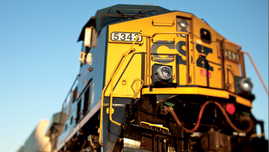Providence & Worcester, CSX turn to solar to help meet energy needs
 PHOTO/Matt VOLPINI
Charles Rennick of Providence & Worcester Railroad says solar panels like the ones behind him provide half of their value to the freight carrier through energy cost savings, and the other half from sales of Massachusetts solar renewable energy certificates, or SRECs.
PHOTO/Matt VOLPINI
Charles Rennick of Providence & Worcester Railroad says solar panels like the ones behind him provide half of their value to the freight carrier through energy cost savings, and the other half from sales of Massachusetts solar renewable energy certificates, or SRECs.
When it comes to the environment, the railroad industry's bona fides are clear — trains use far less fuel than trucks to move goods from one place to another and produce much less pollution. But Providence & Worcester Railroad is taking things one step further. Its engine house in Worcester is now home to a 209-kilowatt solar array that satisfies half of its electrical demand.
“It seemed like a good opportunity to offset some of our energy costs and also have a green-minded focus,” said Charles Rennick, secretary and general counsel for P&W.
P&W began dabbling in solar power with the installation of tiny solar systems at a handful of crossing stations. The 0.5- to 1-kW systems, developed by Solect Energy Development of Hopkinton, sit atop signalling boxes and provide much of the energy the stations use.
“Solar fit very perfectly on top of the hoods,” said Scott Howe, a business development partner at Solect. “They liked that. It went very well.”
P&W engineering director Bernard Cartier said in a statement last year that, even though the stations use just a little power, “every dollar counts” and using solar is both good for the environment and controlling costs.
After that initial success, the two companies moved forward with the more ambitious plan to power the Worcester engine house with the sun. The installation consists of two systems, Howe said, a ground-mounted system in an open area known as the “forgotten yard” and a rooftop installation on the building itself. Howe said the physical conditions at the rail yard were good for solar — an isolated, open area, and a roof that was a good fit for solar panels.
The financial aspect of the project required a bit more work.
Government incentives
In general, solar electrical projects are made economically viable with state and federal incentives. As a for-profit business, Howe said, P&W was eligible for a 30-percent federal tax credit on the system. But, he said, the company already gets federal railroad tax credits that leave it with a no need for further tax breaks.
To make the tax credits work for P&W, the companies sought help from Key Equipment Finance, a subsidiary of banking company Key Corp. The financing deal with Key Equipment includes its purchase of the credits at a reduced rate, and it also allowed the railroad to pay for the system over time instead of having to dig into its funding for capital projects.
“The fact that we brought in creative financing allowed them to move ahead,” Howe said. “They wouldn't have been able to go ahead without that.”
Along with the help with financing, Howe said, Solect also took care of paperwork with the relevant regulators to make sure the system's energy generation is being tracked. That's important, in part because it allows the system to receive Massachusetts solar renewable energy certificates, or SRECs, under a state program. The SRECs can be sold to utility providers.
Rennick said the solar panels, which went online at the end of 2013, provide half their financial value to the company through the direct reduction of energy costs and half from the SREC sales. He said P&W is looking at adding more solar panels to its main office.
“We will continue to explore other areas where green energy sources are beneficial to our neighbors, our customers, and to the company,” he said.
P&W isn't the only railroad looking to the sun for cost savings and environmental benefits. CSX uses solar panels to heat water and provide power at its Worcester administration building. Nationwide, it also uses solar for certain applications that call for small amounts of power in far-flung locations, similar to the P&W crossing stations.
Some of the rail cars CSX uses to lay down ballast, the stony material used for track beds, have solar-powered batteries that open and close hopper doors to release the material. In other locations, the company uses solar power to help heat water and generate backup power for signal systems.
CSX also announced last year that it was buying renewable energy credits equivalent to up to 21 million pounds of carbon dioxide as part of winning LEED certification for its headquarters building in Jacksonville, Fla.
“CSX places great importance on environmental stewardship and leadership in its operations and in the design and development of facilities,” the company said in an emailed statement.
For P&W, Rennick said, continued efforts to reduce energy costs and use renewable power sources are part of a 20-year plan for internal investments and cost management. “But it's also kind of a 'good neighbor' idea because it's kind of pushing the idea of offsetting some of your impact by greening your business,” he said.













0 Comments